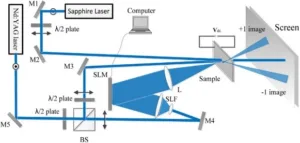Holographic Displays – One approach to the creation of a holographic display is based on the use of dynamic recording materials. One challenge in the development of a real-time holographic display of this type has been the identification of suitable photorefractive materials. More specifically, materials having the fast response and high modulation index necessary to achieve a reasonable diffraction efficiency.
A team of researchers headed by Yikai Su, a professor in the Electronic Engineering Department at the Shanghai Jiao Tong University (Shanghai, China), have just reported what may be a significant advance in this technology. A recent article by the team was published on September 29 in the SPIE Newsroom and can be found here.
The article starts by discussing a real-time holographic display based on a liquid crystal doped with an azo dye. Note that this approach does not require the application of an electric field to the liquid crystal cell as is the case in conventional liquid crystal displays.
The team measured the performance of the system by studying the response time, including both the writing and erasing time. It was found that, by adjusting parameters such as the recording intensity, polarization direction and polarization state, a response time was measured on the order of several milliseconds. This is sufficiently fast to demonstrate video at a rate of 25 Hz, sufficient for some display applications.
The system can function with various colors of probe lights. This offers the potential for color displays using multiplexing.
The article goes on to point out that because of the low solubility and high mobility of dye molecules in the liquid crystal, the diffraction efficiency and thermal stability of such a system were insufficient. To address these issues, the team went on to investigate semiconductor nanoparticle-doped liquid crystal materials. “These materials are photorefractive, meaning that their refractive index can be altered by the electric field generated when the crystal is exposed to coherent illumination, and by the polarization and propagation direction of the light. By doping indium phosphide zinc sulfide quantum dots into the liquid crystal, it was found possible to greatly enhance the photorefractive effect. The size of the quantum dots is not significant in this application, since these experiments exploit a photo-generated space charge effect that does not rely on photoluminescence. With an external voltage applied to the material, the device exhibited a fast response, and a significantly improved diffraction efficiency of 20%, up 33-fold from 0.6% in the case of azo-dye-doped liquid crystal”.
The materials used in this study are reported as widely available. Since the method is claimed to be scalable, this approach would seem to be promising for use in large, dynamic, full color holographic displays. In the future, the team plans to work on achieving higher diffraction efficiency, larger panel size, higher resolution, a wider viewing angle and color multiplexing. – Arthur Berman
Shanghai Jiao Tong University, Su Yikai, +86-21-34204371, [email protected]

